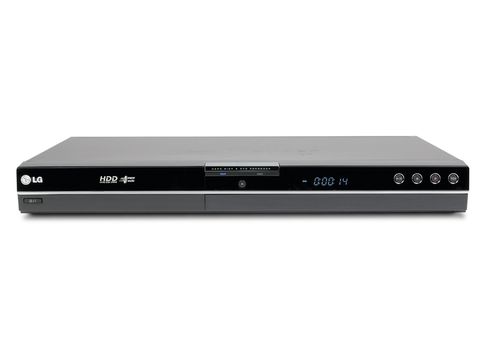TechRadar Verdict
A superb value all-rounder with generous features and solid performance, but lacks the overall slickness needed to really impress
Pros
- +
Great range of features
- +
Excellent recording quality
Cons
- -
Fiddly remote
- -
Freeview+ implementation
- -
Display is difficult to read
Why you can trust TechRadar
The LG RHT399H behaves more like a Freeview PVR or Sky+ box than an old-style DVD combi, enabling you to record an entire series at the push of a button, avoid scheduling conflicts and pause live TV while you make a cup of tea.
Of course, until we get DVD machines with twin digital tuners they'll still feel like second best, but it's a step in the right direction.
The LG RHT399H is an attractive deck, dressed entirely in black except for a few silver strips that inject some pizzazz. While beautifully built and remarkably slim for a combi, the front display panel is hard to read.
Bundles of storage
The deck's massive 320GB drive enables you to store up to 935hr of TV, but if that's overkill then 250GB and 160GB versions are also available. As for DVD formats, the LG takes all-comers except for -R
DL, but with +R DL on board that's no great loss.
There are built-in Freeview and analogue tuners, and the former brings with it digital text and an eight-day EPG.
As for connections, the LG offers all the essential sockets. Most notable is the HDMI output, which offers upscaled 1080p, 1080i and 720p signals, plus we're pleased to see an RGB-enabled Scart and a DV input on the front panel.
Recording features
Elsewhere the deck doesn't skimp on recording and editing features, offering five recording
modes (XP, SP, LP, EP and MLP) that fit between 1 and 14hr on a DVD, or between 3 and 21hr on a
DVD+R DL disc. And because the hard disk can fit up to 85 hours of programmes in the best-quality XP mode, it'll be a while before you have to worry about changing modes for hard-disk recordings.
Chapter markers are added automatically at 5, 10 or 15min intervals, but there's no smart chaptering mode as per Philips' and Pioneer's latest machines.
Editing features include the ability to delete part of a recording, combine two titles and split a title in two, but when using DVD-RAM or DVD-RW discs (formatted in VR mode) you can also rearrange chapters into a new sequence.
Finally the Timeshift feature lets you pause and rewind live TV, and you can also keep whatever's stored in the six-hour buffer memory using the Clip Recording feature.
LG's clever menus
The LG's onscreen menus are jazzily presented and dissolve when you exit them. The clever main menu divides all your media into the relevant types and arranges them in a scrolling bar across the top of the screen. The setup and recording mode menus are also found here, which are straightforward, but it's irksome having to enter the menu each time you want to change recording mode.
The unit is quick and responsive and the Freeview works smoothly, especially the impressive EPG which enables to you switch between timeline and now/next views. The Freeview+ features we mentioned earlier are accessed from here, but the machine's pidgin English makes them harder to understand than they should be – the series link option, for instance, is translated into 'It can be recorded as series', plus the deck has to be told to record a split programme rather than doing it automatically.
Also disappointing is the remote, which while crammed with tiny buttons, gives no prominence to the programme change and EPG keys, and it lacks a dedicated button for changing the recording mode.
Solid picture performance
Live Freeview pictures look fine, boasting bold, vivid colours, clean edges and sharp detail – best demonstrated by the studio segments of BBC News 24 or Sky News.
There is a noticeable amount of block and mosquito noise in the picture, which gives it a slightly shimmery, smeary quality at times, but it's no worse than any other Freeview receiver we've tested. What's more, the HDMI output and 1080p upscaling make the image look just a touch sharper than it does from the RGB Scart output.
The LG does a great job of capturing these images on the hard disk or DVD, and in XP mode there's no difference between live and recorded pictures. In fact there isn't a great deal of difference in SP mode either; it's only when you hit LP that recordings start to look soft and noisy but far from unwatchable.
The HT399H also turns in a solid performance with pre-recorded DVDs, giving films a pleasingly cinematic look with healthy levels of colour, detail and contrast, but as it's not a dedicated DVD player, some of the artefacts on display are only to be expected.
Audio finesse
The LG performs its basic sonic tasks without any flaws.
Freeview audio is recorded in stereo Dolby Digital and sounds crisp when played through TV speakers, despite the compression used to encode it.
It also gets stuck into CDs with more finesse than you'd expect from a recorder, and multichannel movie soundtracks sound scintillating through a decent system.
Great value DVD deck
On balance, you actually get a lot for your money.
The LG RHT399H ticks all the basic boxes: a large hard disk, multi-format DVD recording, Freeview+, versatile editing features – but throws in a few spicy extras such as 1080p upscaling and hard disk multimedia playback that are the sort of extras you'd find on pricier decks from Panasonic and Pioneer.
Only the LG's occasionally clumsy operating system prevents it from reaching the same standard as its illustrious rivals.

